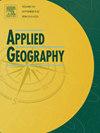沙漠和热点:酒吧和餐馆区位模式的中心性、可达性和社会经济影响的演变
IF 5.4
2区 地球科学
Q1 GEOGRAPHY
引用次数: 0
摘要
关于酒吧和餐馆区位模式的文献没有充分考虑时间动态和城市空间的作用。我们通过开发一个具有双重经验方法的新型城市经济框架来解决这些差距:a)动态纵向泊松模型,该模型结合了社会经济学、人口统计学和可达性,以分析酒吧和餐馆或“热点”集中的时间变化;b)纵向logit方法,模拟酒吧和餐馆“沙漠”的决定因素。我们编制了一个独特的数据集,涵盖了17年(2002-2019)期间(大曼彻斯特和诺丁汉)两个精心挑选的英国城市地区的1100多个小区域。主要发现反映了消费者偏好随着时间的推移发生了根本性的转变。在研究期间,沙洲“沙漠”形成的可能性增加了近20倍,而两个研究区域的沙洲数量减少了约35%。相反,餐馆的数量增加了近35%,餐馆“沙漠”的可能性至少降低了五分之一。尽管泊松规范提供了证据,证明在拥有酒吧和餐厅“生态系统”的地区存在正的路径依赖,但两种方法都显示出显著的可达性、集聚性和社会经济分类效应。本文章由计算机程序翻译,如有差异,请以英文原文为准。
Deserts and hotspots: the evolution of centrality, accessibility, and socio-economic impacts in bar and restaurant location patterns
The literature of bar and restaurant location patterns does not account sufficiently for temporal dynamics and the role of urban spatial. We address these gaps by developing a novel urban economic framework with a two-fold empirical approach: a) dynamic longitudinal Poisson models that incorporate socio-economics, demographics and accessibility to analyse temporal shifts in the concentration of bar and restaurants, or ‘hotspots’; and b) a longitudinal logit approach that models the determinants of bar and restaurant ‘deserts’. We compile a unique dataset of more than 1100 small areas over a 17-year period (2002–2019) across two carefully selected UK city-regions, Greater Manchester and Nottingham. The key findings reflect a fundamental shift in consumer preference over time. During the study period, the probability of bar ‘desert’ formation increased almost 20-fold along with the reduction in bar counts by around 35 percent in both study-areas. Conversely, restaurant numbers have increased by almost 35 percent and the probability of restaurant ‘deserts’ reduced by at least a factor of 5. While, the Poisson specification provides evidence of positive path dependence in areas with an established bar and restaurant ‘ecosystem’, both approaches show significant accessibility, agglomeration, and socioeconomic sorting effects.
求助全文
通过发布文献求助,成功后即可免费获取论文全文。
去求助
来源期刊

Applied Geography
GEOGRAPHY-
CiteScore
8.00
自引率
2.00%
发文量
134
期刊介绍:
Applied Geography is a journal devoted to the publication of research which utilizes geographic approaches (human, physical, nature-society and GIScience) to resolve human problems that have a spatial dimension. These problems may be related to the assessment, management and allocation of the world physical and/or human resources. The underlying rationale of the journal is that only through a clear understanding of the relevant societal, physical, and coupled natural-humans systems can we resolve such problems. Papers are invited on any theme involving the application of geographical theory and methodology in the resolution of human problems.
 求助内容:
求助内容: 应助结果提醒方式:
应助结果提醒方式:


